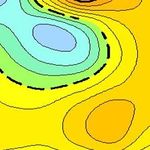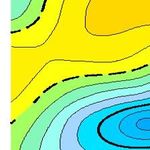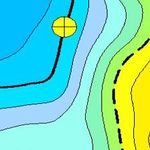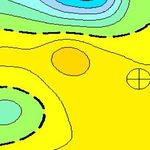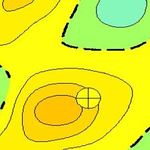The Role of Deep Learning Method Based on Environmental Geochemical Data in Resource
←
→
Page content transcription
If your browser does not render page correctly, please read the page content below
E3S Web of Conferences 245, 02001 (2021) https://doi.org/10.1051/e3sconf/202124502001
AEECS 2021
The Role of Deep Learning Method Based on Environmental
Geochemical Data in Resource
Pei Yao1,*
1College of Geo-exploration Science and Technology, Jilin University, Changchun, China
Abstract. In recent years, with the continuous development of artificial intelligence, deep learning, as an
important method of artificial intelligence learning, has made great progress. At present, deep learning has
been successfully applied in many engineering fields. Environmental science itself involves a wide range,
among which environmental geochemistry is an important branch. The combination of environmental
geochemical problems and deep learning can better study the role of geochemical problems in
environmental investigation, and also can use the basic situation of regional environmental elements to
predict mineral resources.
1 Introduction dimensions at the same time; the other is to use
convolution for dimension lifting. The theory and
The so-called environment is the synthesis of various practicability of this method have been explained in
factors for human survival and development [1]. The detail in the original text, and this paper will not be
application of Geochemistry in the field of environment repeated due to the limitation of space.
can involve many aspects, mainly including the Deep learning is not a sudden technology, but is
following two aspects: one is the original environment realized by multiple small technological advances [4] [5].
directly related to the geological background; the other is In this paper, the method of deep learning is used to
the environment participated by the products of human learn the soil geochemical elements corresponding to the
activities. An important purpose of environmental known deposit location in the region, and then other
geochemical survey is to determine the environmental unknown areas are learned.
background and its changing trend, and monitor it
regularly, so as to provide scientific data for the
protection of human living environment and sustainable
development. Soil is the main medium of environmental
geochemical element survey. Chemical pollutants in soil
and sediment enter food and cause human food chain
poisoning. However, it is less affected by human
activities, and the regional environmental indicators
exceed the standard, which is mostly caused by the
natural geological evolution. Some elements in the soil
are enriched to a certain extent, which may be related to
the occurrence of the deposit.
Fig. 1. basic structure of the inception module
With the rapid development of deep learning, the
application field has expanded from the traditional
natural speech processing, image recognition and speech 2 EXPERIMENTAL DESIGN
recognition to big data analysis and other fields [2]. At
present, a variety of deep learning tools have been
developed, and a variety of optimization methods and 2.1 Sample data
training methods for deep learning have been proposed The data used in this study is 1:50000 soil geochemical
in the field of machine learning. GoogLeNet is a deep data of a certain area in Gansu Province. As a
learning structure proposed by Christian Szegedy in polymetallic metallogenic belt, the Pb element in the
2014. Figure 1 shows the basic structure of the induction study area can not only indicate the impact of heavy
module. Multiple such induction modules are connected metal elements on the environment, but also indicate the
in series to form the whole induction structure [3]. There location of lead-zinc deposits in this area. Therefore, we
are two main contributions of the initiation structure: one use these data to predict the mineral resources in the
is to perform convolution re aggregation on multiple unknown area. First, we use triangulation method to grid
*
Corresponding author: peiyao@jlu.edu.cn
© The Authors, published by EDP Sciences. This is an open access article distributed under the terms of the Creative Commons Attribution License 4.0
(http://creativecommons.org/licenses/by/4.0/).E3S Web of Conferences 245, 02001 (2021) https://doi.org/10.1051/e3sconf/202124502001
AEECS 2021
the data to form the contour map of Pb element training precision adopted in this work are high, which
distribution, and divide it into 551 sample images. In can play a role in the prediction of mineral resources by
these images, there are 288 images with lead-zinc using soil geochemical data in this study area.
deposits, 263 images without lead-zinc deposits, and the
yellow dots in the images with lead-zinc deposits are the
location of the deposits. 3 Test group image prediction
Randomly selected 200 images are taken as the test
group, including 100 images with ore and 100 images
without ore. Some sample images are shown in Figure 5.
The selected test image is input into neural network for
recognition, and some results are shown in Table 1.
(a) (b) (c)
(d) (e) (f)
Fig. 2. Structure diagram of GoogLeNet model
2.2 Data enhancement
The learning of artificial neural network depends on a
large number of training data, the quality of training set
and the number of training samples will have a great (g) (h) (i)
impact on the performance of neural network [6]. Using
mirror flip is to flip the original image up and down and
left and right. In the corresponding pixel data matrix, if
the image is flipped up and down, it shows that the
ordinates of all the pixels are symmetrical with the
ordinates of the corresponding pixels in the original
image about the horizontal centerline of the image. In the (j) (k) (l)
same way, left and right flipping means that the abscissa
of all the pixels after the left and right mirror flipping
operation is symmetrical with the abscissa of the
corresponding pixel in the original image about the
vertical centerline of the image.
Using image enhancement, the original image data is
enhanced, which greatly expands the number of input (m) (n) (o)
images in the training set.
2.3 model training and analysis
The training model used in this study has the following
main parameters: the learning rate is 0.0001, the (p) (q) (r)
maximum epoch is 3, and the selection of validation
frequency is 5. After 8 rounds of training with MATLAB Fig. 3. Structure diagram of GoogLeNet model
software, the training accuracy is 80%, the verification (a) - (i) non ore image; (j) - (r) ore image
accuracy is 79%, and the cross entropy is 0.05. The
training process and main parameter results can be seen
from the curve in Figure 4. The whole training process
adopts single GPU, and the training time lasts for 2
minutes and 56 seconds. It can be seen from the above
parameters that the deep learning framework and
2E3S Web of Conferences 245, 02001 (2021) https://doi.org/10.1051/e3sconf/202124502001
AEECS 2021
image, the recognition rate is 78%; the other is the non
ore bearing image, the recognition rate is 76%. A total of
270 correct images and 40 fault images were identified.
Table 1. Results of metallogenic prediction and recognition of
some images
Classification
recognition
probability Is it
Test Accurac
(%) mineralized
image y
?
Non
Fig. 4. Image recognition training process (blue - training Ore
ore
accuracy; Brown - cross entropy; black - test accuracy)
Test-1 0.98 0.02 no ture
Test-2 0.93 0.07 no ture
Test-3 0.66 0.34 no ture
Test-4 0.71 0.29 no ture
(a) (b) (c) Test-5 0.58 0.42 no ture
Test-6 0.14 0.86 no fault
Test-7 0.76 0.24 no ture
Test-8 0.89 0.11 no ture
Test-9 0.26 0.74 no fault
(d) (e) (f)
Test-10 0.55 0.45 no ture
Test-11 0.79 0.21 no ture
Test-12 0.69 0.31 no ture
Test-13 0.88 0.12 no ture
(g) (h) (i)
Test-14 0.74 0.26 no ture
Test-15 0.86 0.14 no ture
Test-16 0.63 0.37 no ture
Test-17 0.45 0.55 no fault
(j) (k) (l)
Test-18 0.34 0.66 no fault
Test-19 0.47 0.53 no fault
Test-20 0.53 0.47 no ture
Test-21 0.88 0.12 no ture
(m) (n) (o) Test-22 0.78 0.22 no ture
Test-23 0.89 0.11 no ture
Test-24 0.77 0.23 no ture
Test-25 0.59 0.41 no ture
(p) (q) (r) Test-26 0.30 0.70 no fault
Fig. 5. Example of some image test samples
(a) - (i) non ore image; (j) - (r) ore image Test-27 0.51 0.49 no ture
Test-28 0.76 0.24 no ture
As shown in Table 1, there are 310 images in the test
set. The correct results are obtained through recognition, Test-29 0.87 0.13 no ture
and the recognition accuracy is 77%. The image of the
test set is divided into two parts: one is the ore bearing Test-30 0.64 0.36 no ture
3E3S Web of Conferences 245, 02001 (2021) https://doi.org/10.1051/e3sconf/202124502001
AEECS 2021
Deep learning requires a high amount of data, 3. Szegedy C, Liu W, Jia Y., (2014) Going deeper with
because the amount of data plays a very important role in convolutions. 2015 IEEE Conference on Computer
the learning effect of the model. When a certain type of Vision and Pattern Recognition, 2014:1-9.
image data is less, such as the data of non ore image in 4. Hinton, G. E. Deng, L. Yu, D. Dahl, G. E.
the training set is less, it will have a great impact on the Mohamed, A. Jaitly, N. Senior, A. Vanhoucke, V.
prediction effect of non ore image in the test set, leading (2012) Deep neural networks for acoustic modeling
to the phenomenon of prediction error. The number of in speech recognition. IEEE Signal Processing
training rounds will also affect the overall training effect. Magazine, 29(6), 82-97.
For example, this work only trained 8 rounds, reaching
5. Simard, P. Y. Steinkraus, D. Platt, J. C. (2013) Best
nearly 80% of the training accuracy. If the training
practices for convolutional neural networks applied
rounds are increased, the training accuracy will also be
to visual document analysis. In International
greatly increased, but this will also lead to a great
Conference on Document Analysis and Recognition
increase in the time of deep learning. For example, the
(ICDAR), 958-962.
training rounds will increase 5 times, and the same time
will also increase 5 times. Therefore, high performance 6. Xu S.T, Zhou Y.Z, (2018) Artificial intelligence
GPU, or GPU parallel computing, is an important tool identification of ore minerals under microscope
and mainstream method for deep learning. In the follow- based on deep learning algorithm. Acta Petrologica
up work, in order to make the work of this paper more Sinica, 34(11): 3244-3252.
applicable, we should increase the use of high-
performance GPU.
4 Conclusion
Based on deep learning method, this paper mainly
studies the prediction of mineral resources using
environmental geochemical data. The results show that
the primary environmental geochemical pollution is
mostly caused by geological evolution, and it is
relatively possible to find mineral resources near the soil
geochemical anomaly area. Through deep learning
neural network training, the spatial relationship between
geochemical anomalies and ore deposits is found.
Artificial neural network based on deep learning is a
new research method in recent years, which has been
successfully applied in many fields, especially in the
field of image recognition. The level of deep learning for
face recognition and object recognition has been very
close to human. Other difficult image recognition has
also made important progress, such as medical collision
recognition.
However, the application of deep learning in
environmental geochemistry has just started, and there
are still many uncertain factors, so we need to continue
to pay more attention to it. I believe that in the near
future, deep learning in this field, theoretical research
and application will be greatly improved.
Acknowledgments
This work was financially supported by Pilot
demonstration of intelligent mineral geological survey in
typical mining areas fund.
References
1. Jiang, J.Y. Cheng, J.P. Qi, S.H. Xiang, W. (2006)
Applied Geochemistry. China University of
Geosciences Press, Wu Han.
2. Yamashita T. (2018) Gpaphic Deep Learning. Posts
Telecom Press, Bei Jing.
4You can also read




